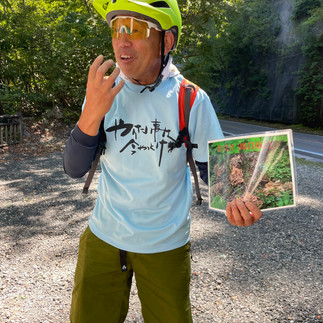
Tales from cycling across the smallest of Japan's main islands
“What are these?” I asked, lifting a small bowl of what looked like translucent, chopped spaghetti for closer inspection.
“The children of eels” Mr. Isao-San said, then typed something into the translation app on his phone and showed me the screen. It was indeed a bowl of baby freshwater eels, topped with a spicy ponzu pepper sauce, a specialty of Kōchi. This was the final night of our 6-day cycling trip across Shikoku Island and our group was celebrating in style at a local seafood feast, complete with an array of saltwater creatures and many rounds of Bekuhai, a beloved local sake-drinking game which translates to "the cup never gets put down."
Shikoku is the smallest of Japan’s four major islands, and a world apart from the buzz and crowds of Honshu’s popular sites and cities. Just over 4 million people call Shikoku home (compared to the nearly 14 million who live in Tokyo) and much of the island is undeveloped wilderness. Dense forests, deep river valleys and rolling mountains in changing shades of green, teal, and navy form a landscape that called to mind Northern Patagonia's Lakes District.
Aside from the Art Islands of Naoshima and Teshima (which are part of Shikoku’s Kagawa prefecture), it is the outdoors that draws visitors to the Shikoku. Many come to embark on the historic 88 Temple Pilgrimage, a 1400 km route that rings the island with stops at numerous sacred Shinto shrines. Some come to venture deep into the "hidden" Iya Valley, its gorges crossed by vine bridges that must be remade every three years. And a growing number travel to Shikoku to road cycle; a joint effort between government and passionate local cyclists has led to the creation of hundreds miles of marked bike lanes and paths. Our little group of adventure travel professionals was there to “test drive” a new route across the island, traveling mostly by e-bike from the Seto Inland Sea to the Southern Pacific Ocean.
Shikoku scenery from the first two days of cycling
There is no high-speed rail connecting Honshu to Shikoku. But there is the Shiminami Kaido, a series of suspension bridges between islands of the Seto Inland Sea that links Shikoku to “the mainland.” The entire 44 mile route is bikeable, though our first day of cycling covered an abridged version. After a Shinto blessing at the Oyamazumi Shrine on Omishima Island, we rolled out of the village and pedaled across light blue bridges and along the waterfront. During the Sengoku period, a turbulent time of constant war during the 15th and 16th centuries (currently being dramatized on Hulu's Shōgun series), these waters were controlled by the Murakami Suigun, a maritime clan that alternated between piracy and providing security services for the emperor. Today much of the route has an industrial feel, but the green islands and turquoise waterways were especially beautiful when viewed from above, on a mid-bridge pause.
Our second day of cycling took us into Shikoku’s spectacular mountainous interior. After
passing beneath a massive Tori gate, we began our big climb for the day, 16 miles and over 4,000’ to the shoulder of Mt. Ishizuchi, the highest peak on the island. Depending on your feelings around road cycling, you may find this climb either hellacious or thrilling, but the Trek e-bikes removed the suffer factor while still enabling a moderate workout. After a lunch of wild boar sausage (and meeting the lovely Ai, who served us tea made from foraged forest herbs), we took off for the famous "UFO line" that snakes along Shikoku's highest ridges. The rest of the day was pure delight, a few steep switchbacks and lots of coasting down smooth roads, surrounded by endless mountains. Plus, roads were nearly free of vehicles, always a bonus when road cycling.

The final two days of our cycling trip followed the Niyado River which runs through Kōchi prefecture until it empties into the Pacific Ocean. Never straying far from the river’s edge, we pedaled through bamboo forests and past small farms, their electric green fields bursting with ginger and rice ready for harvest. Pausing for a coffee break beneath a gingko tree, we had a very “Accidentally Wes Anderson” moment when we were joined by a group of elderly gentlemen, slowly arriving one by one to share tea, a smoke and the daily local gossip. A stop at a tiny hidden shrine revealed tens of thousands of frogs, from garden statues to beanie babies, all left as offerings to cure warts, according to our guide.
Frog shrines, roadside gossip, fields of ginger and the best yuzu flavored rice crips you'll ever eat, each day of our cycling trip contained unexpected delights
But it wasn’t just a two-wheeled dash across the island, with full days in the saddle testing the limits of our battery life. Like any good trip to Japan, food and craft were central themes in connecting with and understanding the local culture. In the town of Ino, we visited the Ino Paper Museum, dedicated to the specific art of "Tosa washi" that was perfected here over 1,000 years ago. The process is labor intensive yet meditative and visitors can make their own delicate sheets of paper, straining and shaking soaked mulberry pulp on specially framed screens.
An artist sifting mulberry pulp at the Ino Paper Museum
At the tiny Ukone restaurant, I savored the best meal of this trip and certainly one of the top meals I’ve enjoyed throughout four trips to Japan. After training at some of the top kitchens in Kyoto and Tokyo, the Chef returned to his home town of Ido with a vision to showcase an elevated take on abundant local ingredients. His menu, crafted around the Sustainable Development Goals, featured pan fried sweet fish from the Niyado River, sautéed Spinach with delicate wild mustard blossoms, pickled ginger sprout, a pleasantly chewy square of taro starch and more, each tiny bento box containing a world of flavors and textures.

Reflecting now on that meal, in that small restaurant that I can't link for you here, because it doesn't exist on the internet or social media, captures what I love most about Japan and travel in general. It doesn't matter where you go, if you follow the crowds to the must-see sights or wander into the country's farther corners; it's the people that you meet and the stories that you share and create together that truly stick with you.
Just a few of the wonderful people of Shikoku who made our trip so fun and special
Need to Know:
Biking: Opportunities for recreational road cycling are still being developed on Shikoku and routes often mix bucolic empty roads through spectacular landscapes with pedals through busy towns, alongside traffic. Road-side paths exist, but they are often crowded with pedestrians. Roads painted with blue lines indicate designated cycling routes, but motorists sometimes gave less space than desired. Unless you are a hard-core cyclist, I would cherry pick the most beautiful days and mix in hiking and sea kayaking for a well-rounded "multi sport" adventure. The Trek e-bikes we used were top of the line and made the cycling approachable for anyone. The sag wagon was never far behind to provide snacks, recharge our bikes during meal breaks or troubleshoot a loose chain.
Language: English is not widely spoken in Japan, especially outside of the main areas visited by tourists. Our local cycling guides were excellent, and a lot of fun (genuine enthusiasm transcends all language barriers), but they did not speak English. Instead we had two lead English-speaking guides (one Japanese, one British who has lived on Shikoku for 30+ years) who escorted our entire trip and acted as translators, along with a mix of local cycling support guides.
Weather: Shikoku can be quite warm, especially along the coast. During our trip in early September it was unseasonably warm with temperatures in the high 90s F on the hottest day, which was why we cut our ride short. If you want to be active on Shikoku, consider the spring (March-May) or late September through early November. Typhoon season in Japan is also something to consider and most intense from late July through early September.
First Trip to Japan? Shikoku isn't usually on the list for first time visitors to Japan, but maybe it should be for you? Every traveler is different and our speciality is crafting a trip that is uniquely you. With 8-10 days our recommendation for most travelers is to stick to Honshu Island. For the quintessentially Japanese juxtaposition of futuristic modernity with ancient tradition, spend time in Tokyo, in Kyoto (taking day trips by bullet train to Himeji Castle, Hiroshima and Miyajima) and in rural Japan, whether that be in the Japanese Alps, the Kii Peninsula or Hakone. Spend at least one night in a traditional onsen ryokan to experience authentic Japanese hospitality. And devote time to immersing yourself in the country's natural beauty, in quieter locations away from the hot spots. With 12-14 days and depending on your interests, you could hike a portion of one of the pilgrimage routes or Edo-period trails, stay overnight in a temple monastery like Koyasan, scratch the surface of another island (Hokkaido, Shikoku or Kyushu) or spend time in the Setouchi Region (the islands and coastlines of the Seto Inland Sea).

Collectively our team has taken six trips to Japan and we look forward to returning at least that many times in the future; each island and region has it's own personality and culture and we feel it's a destination that you'll want to return to time and again.
Intrigued by Japan? Reach out to travel@outlierjourneys.com to start planning.
.png)

















































